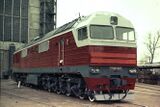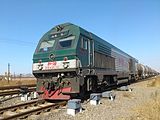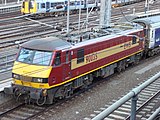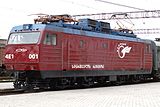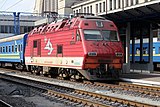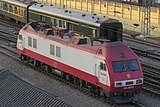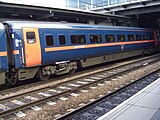User:Holynia/Sandbox
| Holynia | |
|---|---|
| Operation | |
| National railway | Royal Holyn Railway |
| Statistics | |
| Ridership | 2.156 billion (2015) |
| Passenger km | 201 billion (2015) |
| Freight | 2.781 billion tonnes |
| System length | |
| Total | 107,634 km |
| Electrified | 71,041 km |
| High-speed | 1,750 km |
| Track gauge | |
| Main | 1,435 mm (4 ft 8+1⁄2 in) |
| Electrification | |
| Main | 25 kV AC 50 Hz |
Rail transport in Holynia is one of the largest and economically important modes of transport in the country. Holynia has the fourth largest rail networks by length and volume of hauled freight. Holynia has over 100,000 km of railways, of which almost 70,000 is electrified. Traffic levels have increased from rising urbanisation and income levels in Holynia. Almost all operations and track are owned by Royal Holyn Railways, a state owned private company. Several mining companies own and operate seperate rail lines from their mines to ports in western Holynia. Private operators offer luxury train services on the national rail network. Growing investment in the railways has seen improvements in both freight and passenger rail operations. The government of Holynia has designated the rail network as a strategic asset.
Holynia uses 1,435 mm (4 ft 8+1⁄2 in) standard gauge track for the majority of the national network. Some private lines in northern Holynia uses narrow guage or broad guage track. Several tram and light rail lines use narrow guage and urban heavy rail networks use broad guage.
History
The first railway in Holynia was built between Vlkyce and St. Sabas in 1834. This private venture spurred further interest in the technology of rail transport in Holynia. In 1836, the St. Sabas and Brukov Railway opened, becoming the first railway in Holynia to have scheduled passenger services. The Southern Masovia Railway was built in 1841, connecting the ports of Kysuce and Slatnik. The capital, Cizekporok, soon joined the growing number of Holyn cities with railways, when the Cizekporok Southern Railway was established in 1843. In 1847, the Narodna Rada passed the very first Railway Act, ensuring a "logical" railway would be built. The Narodna Rada would be responsible for issuing "permits" to authorise construction of new railways. In addition, the Crown would back all bonds issued by railways in the event they failed. Throughout the 1850s, the railway network in Holynia began to rapidly expand. The 1860s and 70s would see the beginnings of consolidation in the industry.
By 1880, the railways in Holynia became centered on five major railways, totalling almost 12,000 km of track. The north became dominated by the Cizekporok and Bystrica Railway, with the center dominated by the Cizekporok and Southern Railway and the Obrec Railway. The southern coast and Masovia became the dominion of the Southern Masovia Railway and the western coast, the Milná Rodik Railway Company. The government, under King Leoš II, fiercly supported the expansion of the railway network. Leoš II envisioned Holynia becoming a major trading post for all of Spero, with railways linking landlocked and ice bound nations to the north, with Holynia's southern warm water ports.
One of the major challenges in expanding the railway network was the Gatis. As the Gatis traversed all of northern Holynia, the major city of Bystrica was cut off from the rest of Holynia except for a few narrow passing points. The largest passing point throught the Gatis was the Obrec plains. A major railway, the Cizekporok-Bystrica Main Line, already passed through this region. Trains heading south would stop in Cizekporok before heading south or west. This major chokepoint was becoming glaringly obvious as delays into the Cizekporok region became the norm. In 1885, the Cizekporok and Bystrica Railway began exploring building a railway westward from Bystrica through the Gatis.
In 1889, the potential pass, named Brestkovi, was explored and charted by engineers from the Cizekporok and Bystrica Railway. Deemed acceptable, government funding was granted and the railway was completed in 1891. This succesful completion of the line spurred further exploration efforts through the Gatis. By 1900, several passes had been sucessfully built through the Gatis. The development coincided with rapid industrialisation in Holynia, neccesitating growing coal needs. The railways continued to expand their networks and capabilities to feed the growing demand.
The early 1900s would see upheaval for the railway industry in Holynia. Parts of the railway network were destroyed during the Great Spero War when Grola launched an offensive on northern Holynia. The railways, nontheless, became essential to the war effort as they were the principal means of moving soldiers and equipment across the country. In 1920, with the cessation of the war, the government faced immense budgetary issues and defaulted on bonds issued to fund the massive railway expansion. As the country fell into revolution, large portions of the railway network fell into disuse as railway workers join calls to strike. By 1925, the last of the railway companies had failed and all railways were now owned by the government. Despite this, portions of the network were actively supporting revolutionaries by moving weaponry and equipment for the Workers' Party.
The Ministry of the People's Railways assumed responsibility of the railways after the 1927 formation of the Union of Holyn Socialist States. A major emphasis was placed on expanding the railway network. From capacity increases to electrification, the railways were deemed essential to growing the command economy of Holynia. By 1945, the railways totaled almost 100,000 km of track, of which 40,000 km was electrified.
The improvements to the railway network required immense government support for the railways. The 1950s saw reduction in support as the government invested in building motorways and airports. Despite this,
Railway administration
The railways in Holynia are divided into three categories: the national network, private networks and municipal networks. The national network is run and administered by Royal Holyn Railways. Royal Holyn Railways is a public company owned entirely by the Holyn government. Several private operators provide services on the national network under access agreements. In addition, most commuter and suburban railway services are administered and funded by local bodies and operated by KHZ. These services operated on the national network.
The seperate private networks are owned and operated by various private enterprises and are generally isolated from the national network, with a few exceptions. Municipal networks are metro systems and tram networks, which are also isolated from the national network.
The Ministry of Transport is the regulatory body for the railways in Holynia. This task is carried out through the Rail Authority, a sub-ministerial branch of the Ministry of Transport. National rail policy, set by the Narodna Rada, is executed through the Ministry of Transport. The Ministry has regulatory oversight to ensure compliance with safety rules and ensure the railway is meeting the standards set out by the government.
Royal Holyn Railways receives national government funding through the annual Railway Act. The Railway Act, which in addition to funding the railway, outlines priorities for the network. Local investment, from both regional and municipal authorities, has aimed to improve passenger services within their respective jurisdictions.
Railway sectors
- Passenger sector
- High speed division
- Intercity Express division
- Intercity division
- Regional division
- Overnight division
- Suburban division
- Freight sector
- Bulk division
- Heavy haul subdivision
- General goods division
- Local services subdivision
- Express division
- Intermodal division
- Bulk division
Operators
National network
- Royal Holyn Railways (KHZ): Government owned public company operating passenger and freight services.
- Interlink: 50% KHZ owned, 50% Holport owned public company operating express intermodal freight services.
- Oba: Private operator, 10% KHZ ownership, operating intercity services between Cizekporok and Brosvick, Movargovina.
- Holyn Rail Freight: Private freight company operating general goods, bulk cargo and intermodal freight services.
Private networks
Coal
- Wolansky Resources: Private 310 km coal line in northern Holynia.
- Slestvak A.S.: 3 private (750 km total) coal lines in northern Holynia.
Iron Ore
- Slestvak A.S.: 2 private lines (total 410 km lines) in northern Holynia.
Municipal networks
- DopravnýPodnikCizekporok (DPC): Public transport operator in Cizekporok, operating 290 km of underground rapid metro trains, 15 km of light rail trains, 210 km of tram trains.
- Bystrica tranzit (BT): Public transport operator in Bystrica.
- Doprovany Uhrov (DU): Public transport operator in Uhrov.
Railway links with adjacent countries
- Movargovina: Same guage, same voltage (4 electric lines, 3 non-electrified)
- Grola: Same guage, voltage change 3 kV DC/15 kV AC (2 electric lines, 3 non-electrified)
- Stesopol: Same guage, same voltage (2 lines), voltage change 3 kV DC (1 line), 2 non-electrified lines
- Grola: Same guage, voltage change 3 kV DC/15 kV AC (2 electric lines, 2 non-electrified)
- Elmad: Break-of-gauge 1,435 mm (4 ft 8+1⁄2 in)/1,524 mm (5 ft), voltage change 3 kV DC (1 electric line, 2 non-electric)
- Corvia: Break-of-gauge 1,435 mm (4 ft 8+1⁄2 in)/1,524 mm (5 ft), voltage change 3 kV DC (1 electric line)
- Bogoria: Same guage, same voltage (7 electric lines, 8 non-electrified)
 | |
| State owned public limited company | |
| Industry | Railways |
| Predecessor | Holyn State Railways (1941-2002) |
| Founded | 10 May 2002 |
| Headquarters | , |
Area served | Holynia |
| Services | Rail transport, Cargo |
| Owner | Holyn government (100%) |
Number of employees | 110,000 (2018) |
| Website | Holyn Railways (English) |
Rolling stock
Holynia has a rail inventory of 12,421 locomotives in 2017. Electric locomotives comprise roughly 60% of the fleet, with the remaining 40% being diesel powered. Around 90% of the fleet is owned and operated by KHZ, with the remaining 10% owned by private ventures. An additional 1,000 multiple unit sets are used in passenger services. The entirety of the electric fleet is AC transmission, operating on 25 kV, 50 Hz. The average age of the locomotive fleet is 25 years as of 2015. KHZ is undergoing an intensive modernisation effort of its passenger rolling stock, both rebuilding older equipment and procuring new rail cars. The locomotive fleet is also being updated, with most older diesels being phased out of service. Emmission regulations are neccesitating further fleet modernization efforts, as older diesels fail to meet upcoming requirements.
Diesel-electric locomotives
| Class | Entered service | Use | Number in service | Power output | Remarks |
|---|---|---|---|---|---|
| 105 | 1970 | General goods/pusher/work trains | 82 | 2,208 kW (2,961 hp) | Will be retired 2025. |
| 106 | 1975 | General goods/bulk cargo/work trains | 567 | 1,472 kW (1,974 hp) | |
| 109 | 1977 | General goods/work trains | 781 | 1,103 kW (1,479 hp) | |
| 110 | 1979 | Yard switcher/local train/work trains | 82 | 2,350 kW (2,150 hp) | |
| 112 | 1980 | General goods/bulk cargo/intermodal | 1,214 | 4,500 kW (6,035 hp) | |
| 114 | 1984 | Yard switcher/local train/work trains | 106 | 3,000 kW (4,000 hp) | |
| 117 | 1989 | General goods/bulk cargo/intermodal | 47 | 2 x 6,000 hp | |
| 120 | 1999 | Passenger trains | 201 | 1,864 kW (2,500 hp) | |
| 121 | 1999 | General goods/bulk cargo/intermodal/work trains | 357 | 2,240 kW (3,000 hp) | Tight loading gauge compliant locomotives |
| 124 | 2005 | General goods/bulk cargo/intermodal/work trains | 406 | 5,000 kW (6,705 hp) total | Typically a married pair of 2 units. |
| 127 | 2007 | General goods/bulk cargo/intermodal/work trains | 61 | 3,184 kW (4,270 hp) | |
| 129 | 2010 | General goods/bulk cargo/intermodal/work trains | 301 | 4,700 kW (6,300 hp) | |
| 130 | 2010 | General goods/bulk cargo/intermodal/work trains | 200 | 9,300 hp | 3 106 married locomotives with cabless "B" unit |
| 132 | 2012 | Passenger trains | 76 | 2,800 kW (3,800 hp) | |
| 133 | 2014 | General goods/bulk cargo/intermodal/work trains | 407 | 2,000 kW (2,700 hp) | |
| 134 | 2015 | General goods/bulk cargo/intermodal/work trains | 975 | 4,660 kW (6,250 hp) |
Electric locomotives
| Class | Entered service | Use | Number in service | Remarks |
|---|---|---|---|---|
| 424 | 1977 | Cargo division | 41 | Limited service, expected to be retired by 2023. |
| 429 | 1979 | Cargo division | 82 | |
| 430 | 1980 | Passenger/Cargo divisions | 517 | |
| 431 | 1984 | Passenger/Cargo divisions | 879 | |
| 433 | 1982 | Cargo division | 63 | |
| 435 | 1989 | Passenger division | 81 | Designed to operate with Series 5 coaches. |
| 436 | 1993 | Passenger/Cargo divisions | 50 | |
| 439 | 1996 | Passenger division | 22 | |
| 440 | 2001 | Cargo division | 871 | Married pair designed for heavy haul services |
| 441 | 2002 | Passenger division | 81 | |
| 443 | 2005 | Passenger/Cargo divisions | 137 | |
| 447 | 2006 | Cargo division | 87 | Married pair |
| 449 | 2007 | Cargo division | 1,150 | |
| 450 | 2009 | Cargo division | 622 | Married pair designed for heavy haul services. |
| 452 | 2012 | Passenger/Cargo divisions | 95 | |
| 453 | 2012 | Cargo division | 527 | Second generation of Class 449 |
| 454 | 2014 | Passenger/Cargo divisions | 527 | Second generation of Class 449 |
| 455 | 2015 | Passenger division | 91 | |
| 456 | 2016 | Passenger/Cargo divisions | 762 | Intended to replace older electric locomotives |
Diesel multiple units
Electric multiple units
Passenger cars
Organization of the Holyn Ground Forces
Holyn Ground Force Headquarters
- Capital Defence Command (Cizekporok, Holynia)
- 9th Guards Tank Household Division
- Division Headquarters
- 12th Command Brigade
- 2nd Royal Life Guards Tank Regiment (HT-15, HT-90AZ, BVP-3, OT-6)
- 4th Guards Tank Regiment (HT-90AZ, HT-85BV, OT-5)
- 5th Royal Guards Hussars Regiment (HT-90AZ, HT-85BV, BVP-3, OT-5)
- 3rd Guards Motor Rifle Regiment (HT-85BV, BVP-3, OT-6, OT-5)
- 93rd Guards Artillery Regiment (MD-93, MD-80V)
- 651st Rocket Artillery Regiment (RM-70, RM-91)
- 60th Guards Air Defence Regiment (PS-08, PS-87, PS-88)
- 191st Anti-Tank Battalion
- 90th Guards Engineer Battalion
- 53rd Guards ISTAR Battalion
- 79th Signals Battalion
- 23rd Guards NBC-defence Battalion
- 70th NBC-defence Battalion
- 501st Aviation Company
- 156th Medical Battalion
- 1st Maintenance Battalion
- 10th Logistics/Supply Battalion
- 9th Guards Tank Household Division
- Special Operations Command
- 15th Special Operations Brigade
- 18th Special Operations Brigade
Ground Force Training and Support Command
- Military Academy of the General Staff
- Combined Arms Academy
- Engineering Institute
- Artillery Institute
- Signals and Communications Institude
- Military Logistics Academy
- NBC Protection Academy
- NBC warfare Insitute
- Military Engineering College
- Maintanence Institute
- Warrant Officer Academy
- Officer Academy
- Active Combined Arms Training Regiment
- Initial Military Training
- Leader Option Brigade
- Warfare Training Brigade
Ground Operations Command
- Northern Military Command (Bystrica, Holynia)
- 1st Guards Tank Division (HT-85BV2, HT-85BV, BVP-3, BVP-2, OT-6, OT-5)
- 15th Tank Regiment
- 11th Guards Tank Regiment
- 56th Tank Regiment
- 59th Tank Regiment
- 7th Guards Motor Rifle Regiment
- 50th Guards Artillery Regiment
- Royal Artillery Regiment
- 8th Rocket Artillery Regiment
- 7th Air Defence Regiment
- 20th Air Defence Regiment
- 97th Reconaisiance Company
- 83rd Anti-Tank Battalion
- 91st Guards Anti-Tank Battalion
- 457th Intelligence Battalion
- 95th Signals Battalion
- 905th NBC-defence Battalion
- 12th Aviation Company
- 451st Medical Battalion
- 100th Maintenance Battalion
- 204th Logistics/Supply Battalion
- 4th Guards Motor Rifle Division (HT-90, HT-85BV, BVP-2, OT-6, OT-5)
- 5th Guards Motor Rifle Regiment
- 9th Guards Motor Rifle Regiment
- 14th Motor Rifle Regiment
- 9th Guards Tank Regiment
- 43rd Artillery Regiment
- 71st Rocket Artillery Regiment
- 90th Guards Air Defence Regiment
- 10th Aviation Company
- 2nd Intelligence Battalion
- 91st Signals Battalion
- 15th NBC-defence Battalion
- 203rd Medical Battalion
- 15th Logistics/Supply Battalion
- 1st Guards Tank Division (HT-85BV2, HT-85BV, BVP-3, BVP-2, OT-6, OT-5)
- Central Military Command (Pravek, Holynia)
- 2nd Guards Motor Rifle Division (HT-85BV, HT-75, BVP-2, OT-6, OT-4, OOT-3)
- 91st Guards Motor Rifle Regiment
- 3rd Motor Rifle Regiment
- 17th Guards Tank Regiment
- 67th Artillery Regiment
- 93rd Rocket Artillery Regiment
- 147th Air Defence Regiment
- 411th Aviation Company
- 9th Intellgience Battalion
- 71st Signals Battalion
- 4th NBC-defence Battalion
- 85th Medical Regiment
- 904th Logistics/Supply Battalion
- 5th Guards Motor Rifle Division (HT-85BV, BVP-3, BVP-2, OT-5, OT-4)
- 105th Motor Rifle Regiment
- 33rd Motor Rifle Regiment
- 43rd Motor Rifle Regiment
- 12th Guards Tank Regiment
- 85th Artillery Regiment
- 101st Air Defence Regiment
- 177th Aviation Company
- 456th Intelligence Company
- 93rd Signals Battalion
- 2nd NBC-defence Battalion
- 91st Medical Battalion
- 481st Logistics/Supply Battalion
- 2nd Guards Motor Rifle Division (HT-85BV, HT-75, BVP-2, OT-6, OT-4, OOT-3)
- Western Military Command
- 7th Guards Tank Division (HT-90, HT-85BV, HT-85B, BVP-3, OT-6, OT-5)
- 35th Guards Tank Regiment
- 985th Guards Tank Regiment
- 45th Tank Regiment
- 23rd Guards Motor Rifle Regiment
- 67th Motor Rifle Regiment
- 95th Guards Artillery Regiment
- 10th Rocket Artillery Regiment
- 15th Air Defence Company
- 230th Aviation Company
- 190th Intelligence Company
- 678th Signals Battalion
- 44th NBC-defence Battalion
- 487th Medical Battalion
- 13th Engineering Battalion
- 11th Logistics/Supply Battalion
- 11th Motor Rifle Division (HT-85BV, HT-85B, BVP-3, BVP-2, OT-6, OT-3)
- 30th Guards Motor Rifle Regiment
- 41st Motor Rifle Regiment
- 105th Motor Rifle Regiment
- 9th Guards Tank Regiment
- 533rd Artillery Regiment
- 105th Guards Artillery Regiment
- 9th Air Defence Regiment
- 905th Aviation Company
- 7th Reconaisiance Battalion
- 95th Signals Battalion
- 14th NBC-defence Battalion
- 705th Medical Battalion
- 43rd Engineering Battalion
- 12th Logistics/Supply Battalion
- 7th Guards Tank Division (HT-90, HT-85BV, HT-85B, BVP-3, OT-6, OT-5)
- Southern Military Command
- 8th Motor Rifle Division (HT-85BV2, HT-85BV, BVP-2, OT-6, OT-3)
- 83rd Guards Motor Rifle Regiment
- 70th Motor Rifle Regiment
- 122nd Motor Rifle Regiment
- 19th Guards Tank Regiment
- 21st Artillery Regiment
- 903rd Rocket Artillery Regiment
- 45th Rocket Artillery Regiment
- 145th Air Defence Battalion
- 34th Anti-Tank Regiment
- 2nd Aviation Company
- 91st Reconaisiance Company
- 12th Guards Signals Battalion
- 61st NBC-defence Battalion
- 139th Medical Battalion
- 9th Engineering Battalion
- 121st Logistics/Supply Battalion
- 13th Guards Tank Division (HT-90, HT-85B, HT-75BV, BVP-2, OT-6, OT-5)
- 40th Guards Tank Regiment
- 133rd Tank Regiment
- 156th Tank Regiment
- 121st Motor Rifle Regiment
- 91st Artillery Regiment
- 71st Rocket Artillery Regiment
- 12th Anti-Tank Regiment
- 19th Reconaisiance Company
- 155th Signals Battalion
- 11th NBC-defence Battalion
- 9th Medical Battalion
- 127th Engineering Battalion
- 78th Logistics/Supply Battalion
- 8th Motor Rifle Division (HT-85BV2, HT-85BV, BVP-2, OT-6, OT-3)
- Eastern Military Command
- 6th Guards Tank Division (HT-15, HT-90, HT-85BV, HT-85B, BVP-3, OT-6)
- 9th Guards Motor Rifle Division (HT-90, HT-85BV, BVP-3, BVP-2, OT-6, OT-5)
- 14th Motor Rifle Division (HT-85B, HT-75BV, BVP-3, BVP-2, OT-5, OT-4, OT-3)
- Directly reporting regiments
- 7th Reconnaissance Regiment
- 10th Reconnaissance Regiment
- 5th Guards Combat Engineers Regiment
- 11th Combat Engineers Regiment
- 20th Guards Combat Engineers Regiment
- 15th Logistics Brigade
List of equipment of the Royal Holyn Marines
| Model | Image | Origin | Type | Variant | Number | Details | ||
|---|---|---|---|---|---|---|---|---|
| Main Battle Tanks | ||||||||
| HT-90 Pružný |  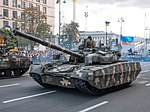
|
125mm main battle tank | HT-90BM
HT-90VM |
Active: 76 Reserve: 13 Active: 42 |
Specialised Marine variants. | |||
| HT-85 | 
|
125mm main battle tank | HT-85BV | Active: 31 | ||||
| Infantry fighting vehicles | ||||||||
| OBV-4 | 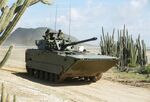
|
Amphibious infantry fighting vehicle | OBV-4A | Active: 104 | ||||
| OBV-3 | 
|
Amphibious infantry fighting vehicle | OBV-3A | Active: 76 | ||||
| BVP-3 | 
|
Infantry fighting vehicle | BVP-3A | Active: 91 | ||||
| Armored personnel carriers | ||||||||
| OT-6 | 
|
Armored personnel carrier | OT-6A | Active: 176 Reserve: 25 |
||||
| OT-5 | 
|
Armored personnel carrier | OT-5A | Active: 62 Reserve:191 |
||||
| OOT-3 | 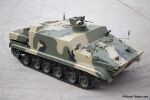
|
Armored personnel carrier | OOT-3 | Active: 31 | ||||
| OOT-2 | 
|
Armored personnel carrier | OOT-2 | Active: 57 Reserve:104 |
||||
| Light armored vehicles (Active: 3,955) | ||||||||
| LOT-150 |  |
Mine-Resistant Ambush Protected Vehicle | LOT-150 | Active: 561 | ||||
| LOT-120 | 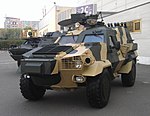 |
Armored car | LOT-120 | Active: 720 | ||||
List of equipment of the Holyn Ground Forces
Vehicles
| Model | Image | Origin | Type | Variant | Number | Details |
|---|---|---|---|---|---|---|
| Main Battle Tanks (Active: 1,627) | ||||||
| HT-15 Jazvec | 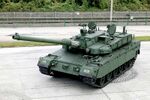
|
125mm main battle tank | HT-15A | Active: 60 On order: 340 |
Ministry of Defence reviewing an additional 200 unit order by 2023. | |
| HT-90 Pružný | 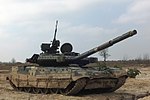 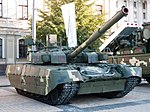 |
125mm main battle tank | HT-90AZ
HT-90B HT-90V |
Active: 453 Reserve: 40 Active: 161 Reserve: 91 Active: 200 |
HT-90AZ - HT-90A upgraded with new sights and sensors, Clona-4 reactive armor replaced Clona-3. HT-90B - Introduced in 2005, retains Clona-3 reactive armor. HT-90V - Most recent variant of HT-90. | |
| HT-85 | 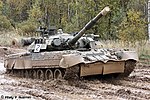   |
125mm main battle tank | HT-85B
HT-85BV HT-85BV2 |
Active: 35 Reserve: 778 Active: 437 Reserve: 1,192 Active: 119 |
HT-85B - Unupgraded HT-85B will be retired by 2025. HT-85BV - A number of HT-85BV vehicles in reserve to be reactivated to replace HT-75. Adds independent thermal imaging sights for the commander. Removes infrared search light. HT-85BV2 - Adds Clona-5 reactive armor. | |
| HT-75 |  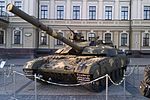 |
125mm main battle tank | HT-75B
HT-75BV |
Active: 125 Reserve: 168 Active: 37 |
HT-75B - Entire fleet will be retired by 2022. HT-75BV - Upgrade program cancelled in 2017 in favour of HT-15. | |
| Fire support vehicle | ||||||
| VPT-20 |  |
Tank combat support vehicle | VPT-20 | Active: 30 | Based on HT-85 chassis. | |
| VPT-10 |  |
Tank combat support vehicle | VPT-10 | Active: 60 Reserve: 48 |
Based on HT-60 chassis. | |
| Infantry fighting vehicle (Active: 2,457) | ||||||
| BVP-3 |  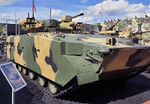  |
Infantry fighting vehicle | BVP-3A
BVP-3V-K BVP-3V-G |
Active: 541 Reserve: 102 Active: 238 Active: 490 Reserve: 29 |
BVP-3A - Armed with 100 mm gun/30 mm autocannon. BVP-3V-K - Increased armour, new 30 mm autocannon turrett. BVP-3V-G - Increased armour, improved thermal sights, armed with 100 mm gun/30 mm autocannon. | |
| BVP-2V Šakal | 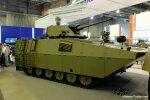 |
Infantry fighting vehicle | BVP-2V | Active: 108 | Equipped with 20mm gun, improved sights and increased armor. No longer amphibious due to added weight. Outstanding orders cancelled in 2018 due to suspension issues. | |
| BVP-2 |  |
Infantry fighting vehicle | BVP-2 | Active: 1,080 Reserve: 2,510 |
||
| Armored personnel carrier (Active: 2,435) | ||||||
| OT-7 |  |
Armored personnel carrier | OT-7A | Active: 20 On order: 180 |
Deliveries began in 2020, 200 OT-7A were ordered to replace OT-4 and OT-3 APCs. | |
| OT-6 | 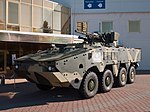 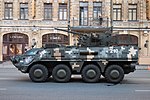 |
Armored personnel carrier | OT-6A
OT-6V |
Active: 1,100 Reserve: 200 Active: 825 |
||
| OT-5 |  |
Armored personnel carrier | OT-5 | Active: 975 Reserve: 145 |
||
| OT-4 |  |
Armored personnel carrier | OT-4 | Active: 139 Reserve: 271 |
||
| OT-3 |  |
Armored personnel carrier | OT-3 | Active: 92 Reserve: 760 |
||
| OOT-3 | 
|
Armored personnel carrier | OOT-3 | Active: 96 Reserve: 30 |
||
| OT-2 |  |
Armored personnel carrier | OT-2 | Active: 13 Reserve: 430 |
||
| Light armored vehicle (Active: 3,955) | ||||||
| LOT-150 |   |
Mine-Resistant Ambush Protected Vehicle | LOT-150 | Active: 1,450 | ||
| LOT-144 |  |
Mine-Resistant Ambush Protected Vehicle | LOT-144 | Active: 130 | ||
| LOT-130 | 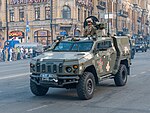 |
Armored car | LOT-130 | Active: 750 | ||
| LOT-120 |  |
Armored car | LOT-120 | Active: 1,400 | ||
| LOT-750 |  |
Heavy Mine-Resistant Ambush Protected Vehicle | LOT-750 | Active: 35 | Used by explosive ordinance removal teams. | |
| LOT-5 |  |
Armored car | LOT-5 | Active: 190 Reserve: 450 |
Used by special operations teams and command units. | |
| Artillery (Active: 3,071) | ||||||
| MD-14 |  |
152mm self-propelled howitzer | MD-14 | Active: 52 | 70 unit order placed in 2016. | |
| MD-93 |  |
152mm self-propelled howitzer | MD-93 | Active: 324 Reserve: 133 |
||
| MD-80 | 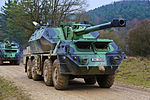  |
152mm self-propelled howitzer | MD-80
MD-80V |
Active: 570 Reserve: 325 Active: 85 |
||
| MD-71 |  |
152mm self-propelled howitzer | MD-71 | Active: 80 Reserve: 210 |
||
| MD-73 |  |
122mm self-propelled howitzer | MD-73 | Active: 310 Reserve: 427 |
||
| MD-89 |  |
120mm self-propelled mortar | MD-89 | Active: 203 Reserve: 56 |
||
| MD-7 |  |
122mm self-propelled mortar | MD-7 | Active: 150 Reserve: 51 |
||
| RM-62 |    |
122mm multiple rocket launcher system | RM-62
RM-62V |
Active: 330 Reserve: 790 Active: 12 |
||
| RM-70 | 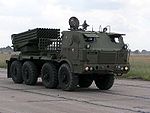  |
122mm multiple rocket launcher system | RM-70 RM-70Z |
Active: 530 Reserve: 610 Active: 140 |
||
| RM-15 |  |
Universal multiple rocket launcher system | RM-15 | Active: 75 | ||
| RM-86 |  |
220mm multiple rocket launcher system | RM-86 | Active: 200 Reserve: 103 |
||
| RM-91 | 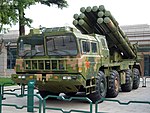 |
300mm multiple rocket launcher system | RM-91 | Active: 120 Reserve: 95 |
||
| RM-95 |  |
220mm multiple rocket launcher system | RM-95 | Active: 30 | ||
| Anti-aircraft vehicles | ||||||
| PS-41 |  |
Self propelled short range air defense system | VPT-10 | Active: 57 Reserve: 48 |
||
| PS-3 |  |
Self propelled short range air defense system | VPT-20 | Active: 53 | BVP-3 with anti-aircraft gun | |
| PS-08 |  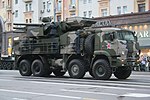 |
Self propelled short range air defense system | PS-08S
PS-08K |
Active: 188
Active: 290 |
||
| PS-87 |  |
Self propelled short range air defense system | VPT-20 | Active: 163 Reserve: 90 |
||
| PS-88 |  |
Self propelled short range air defense system | VPT-20 | Active: 107 Reserve: 82 |
||
| PS-72 |  |
Self propelled short range air defense system | VPT-20 | Active: 85 Reserve: 31 |
||
| PS-88 | 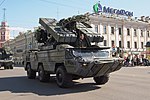 |
Medium range surface to air missile complex | VPT-20 | Active: 310 Reserve: 104 |
||
| PS-74 |  |
Medium range surface to air missile complex | VPT-20 | Active: 62 Reserve: 20 |
||
| PS-95 |  |
Medium range surface to air missile complex | PS-95 | Active: 30 | ||
| PS-105 |  |
Long range surface to air missile complex | PS-105 | Active: 42 | ||
| PS-12 | 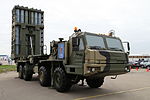 |
Long range surface to air missile complex | PS-12 | Active: 2 | ||
| PS-110 |  |
Long range surface to air missile complex | PS-110 | Active: 23 | ||
| PS-100 |  |
Long-range surface to air missile complex | PS-100 | Active: 15 | ||
| Tank destroyers (Active: 379) | ||||||
| P-99 |  |
Mobile anti-tank guided missile system | P-99 | 207 | ||
| P-98 |  |
Mobile anti-tank guided missile system | P-98 | 72 | ||
| P-15 |  |
Mobile anti-tank guided missile system | P-15 | 100 | ||
| Logistics vehicles | ||||||
| D-6510 | 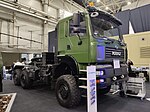 |
Heavy truck | D-6510 | |||
| D-7510 |  |
Heavy truck | D-7510 | |||
| D-7710 |  |
Heavy truck | D-7710 | |||
| D-055 | 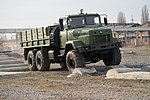 |
Heavy truck | D-055 | 500+ | ||
| D-050 |  |
Heavy truck | D-050 | 1,000+ | ||
| D-045 |  |
Heavy truck | D-050 | 200+ | ||
| D-060 |  |
Heavy truck | D-050 | 200+ | ||
| D-070 |  |
Heavy truck | D-050 | 200+ | ||
| D-071 |  |
Medium truck | D-050 | 200+ | ||
| D-078 |  |
Medium truck | D-050 | 500+ | ||
| D-099 |  |
Medium truck | D-050 | |||
| D-091 |  |
Medium truck | D-050 | |||
| D-103 |  |
Medium truck | D-050 | |||
| TD-90 | 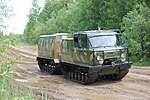 |
Tracked transport vehicle | D-050 | |||
| TD-95 | 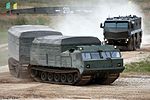 |
Tracked transport vehicle | D-050 | |||
| Armored recovery vehicle | ||||||
| OVV-90 | 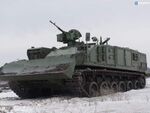 |
Armored recovery vehicle | OVV-90 | |||
| OVV-85 |  |
Armored recovery vehicle | OVV-85 | |||
| OVV-75 |  |
Armored recovery vehicle | OVV-75 | |||
| OVV-3 | 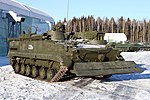 |
Armored recovery vehicle | OVV-3 | |||
| OVV-6 |  |
Armored recovery vehicle | OVV-6 | |||
| Military engineering vehicles | ||||||
| MC-75 |  |
Mine clearing vehicle | MC-75 | |||
| MC-85 |  |
Mine clearing vehicle | MC-85 | |||
| MC-71 |  |
Mine clearing vehicle | MC-71 | |||
| MV-75 |  |
Mine laying vehicle | MV-75 | |||
| DS-75 |  |
Trencher | DS-75 | |||
| DS-89 |  |
Trencher | DS-89 | |||
| BD-788 |  |
Combat bulldozer | TD-801 | |||
| BD-788 | 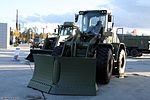 |
Combat bulldozer | TD-801 | |||
| DS-99 |  |
Armored tracklayer | DS-99 | |||
| S-8771 |  |
Armored tracklayer | S-8771 | |||
| BD-97 |  |
Combat bulldozer | BD-97 | |||
| OD-9411 |  |
Military drilling vehicle | OD-9411 | |||
| TD-901 |  |
Heavy tracked transporter | TD-901 | |||
| TD-801 |  |
Tracked transporter | TD-801 | |||
| BI-99 |  |
Engineering support vehicle | BI-99 | |||
| Bridge lauching vehicles | ||||||
| PM-90 |  |
Armoured vehicle-launched bridge | PM-90 | |||
| PM-75 |  |
Armoured vehicle-launched bridge | PM-75 | |||
| OD-95 |  |
Amphibious bridging vehicle | BD-97 | |||
| D-07 |  |
Bridge layer | D-07 | |||
| S-9091 | 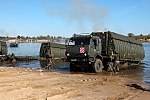 |
Floating bridge layer | DS-99 | |||
| OD-87 | 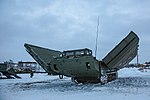 |
Amphibious bridging vehicle | OD-87 | |||
| Royal Holyn Navy | |
|---|---|
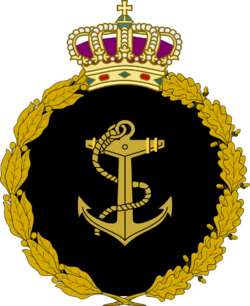 Emblem of the Royal Holyn Navy | |
| Founded | 17 February 1891 |
| Country | |
| Type | Navy |
| Role | Naval warfare |
| Size |
|
| Part of | |
| Fleet |
|
| Engagements |
|
| Commanders | |
| Commander | Admiral Viktor Volf |
| Ceremonial chief | Admiral |
| Insignia | |
| Flag and ensign |  |
| Jack |  |
| Badge | 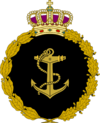 |
The Royal Holyn Navy is the naval warfare branch of the Royal Holyn Defence Forces. It has existed in a number of forms since the 16th century. The current iteration was formed in 1999, when it inherited the navy of the Holyn Socialist Union. It is the second largest branch of the Holyn military.
Holynia maintained a large surface fleet of armed merchant ships from the 1500s to late 1600s. In 1661, the first formal Holyn Navy was formed becoming the official naval fighting branch of the King. During the Holyn Civil War, much of the navy had joined the communist rebellion. During the communist era, the Navy received increased investment. It transformed from a green water navy in the 1940s to a true blue water navy by the 1970s. The Navy reached its largest size in 1990, with 501 combat ships.
Following the fall of communism, the Navy had its budget significantly reduced. Procurement all but stopped by 1999. The early 2000s saw limited procurement of new ships. Military reforms in 2005 saw heavy emphasis placed on maintaining a powerful navy. The renewed focus on the Navy saw major restructuring of the Navy around designing new destroyers, cruisers and amphibious assault ships.
History
The Holyn Navy traces much of its history to to the battle force assembled by Alex I during the Catastrophe in the 12th century. A decisive naval battle between sailing ships of the Grolan Empire and the Holyn Realm cemented Holynia as a naval power. Following the reconstruction period in the 12th and 13th centuries, Holynia's various trading enterprises were tasked with exploration and colononization of the northern Sayuin coast. The ships of the King, as they officially were called, were ships under direct command of the King and the de-facto Navy of Holynia during this period. Navy ships were not tasked with exploration or colonising duties, but did escort private vessels through the busy Great Spero Sea.
The Navy was again sidelined during the initial periods of Holyn colonising in Navron during the 16th century, with the King opting to utilize private trading companies to conquer these lands. However, the colony of Skoskie became a major naval hub in the 17th century, allowing the monarchy close oversight of the privateer Holyn fleets operating here.
In the 19th century, the Navy participated in its first major battle since the Catastrophy, again with the Grolan Empire. This saw the worlds first usage of steam ships in battle. A series of defeats saw the Holyn Navy decisive defeats in the Northern Spero Sea saw Holynia's navy sidelined to coastal defence. However, the Royal Holyn Navy was instrumental in the Battle of Relo, where Holyn ships shelled the city. During this century, the Royal Holyn Navy inherited more duties of exploration. Private individuals and companies became more restricted in their ability to use force, so Navy ships were required to escort research companies. As industrialisation expanded in Holynia, the shipbuilding abilities of the country improved. Holynia operated the 3rd largest navy in Spero by 1900.
This became instrumental as Holynia possesed the largest Navy of the Eastern Powers during the Great Spero War in 1917. The Holyn Navy was credited with forcing the stalemate which ended the war, following a series of decisive battles in western Spero. The Holyn Navy, however, sufferred in the political chaos of the early 20th century.
The Royal Navy remained loyal to the monarchy, providing safe haven and transport during the Great Escape of 1927. The Royal Navy fled mainland Holynia, with the Royal Family, to the overseas colony of Skoskie. The Royal Navy provided the basis of the Navy of newly independent Skoskie during the 1930s.
The Communists found themselves with outdated ships left behind during the Great Escape. The modern, capable ships had fled the ports prior to their capture by the Communists. Only outdated, small ships were abandoned.
The government of the newly founded Union of Holyn Socialist States founded the Fleet of the Workers. As the effort to rebuild the nation progressed, the new military command put emphasis on the ground army. By 1935, the military began to plan a build up of the Navy. Neighboring powers in Spero were putting major emphasis on building powerful Navies and Air Forces, while Holynia had a small coastal force and limited aerial forces. Shipbuilding capabilities began to be ramped up in the 1930s. Holyn shipyards, by 1933, were capable of building 10,000 tonne civilian ships, but were given the task of building roughly 60,000 tonne battleships.
This fleet of battleships came at a time of growing competitition between the naval powers of Spero. The death of Volen Hajek saw a major reorganization of the military. New leader Jan Kříž put a heavy emphasis on overseas expansion of communism and saw the Navy as a critical asset. The Navy was reorganized into the Western Fleet, Central Fleet, and the Eastern Fleet. Its headquarters was established in Slatnik.
By 1945, the Navy had a fleet of 10 battleships, 4 Rolník class and 6 Chránit class battleships. These were the new flagships of the Navy. In 1947, Holynia launched its first overseas endeavor into Navron. Salcheny, a colony of Pamtoria, was fighting a war of independence. The Holyn Navy deployed several warships and transport ships to support the communist faction, the Salcheny People's Liberation Army. The withdrawal of Pamtoria was seen largely as the consequence of the Holyn deployment. The SPLA rapidly increased its capabilities after arms shipments from Holynia.
The Navy numbered roughly 300 ships by 1950. Construction efforts focused on cruisers, submarines and small missile boats. Throughout the 1960s, the Navy began to place significant emphasis on fleet defence capabilities, primarily through mid-sized aircraft carriers and small missile boats. Ships of all sizes had their decks packed with long range missiles. Submarine technology was also significantly improved on during the 1960s.
In 1973, the first Utena class aircraft carrier was commissioned. The 1970s and 1980s would see immense improvements of the capabilities of the Navy. The nuclear powered Pozorká class heavy battlecruisers were introduced in the 1980s, alongside Project 166 and Project 170 destroyers.
The diversification of various ship classes would come to an end in the 1990s. Commander of the Navy, Admiral Jaroslav Kopecký, sought to simplify the fleet. The growing budget issues of the government helped this endeavour. Procurement emphasised universal platforms, contrasting with ships built for a single purpose.
Ship procurement steadily declined in the 1990s, all but coming to a halt by 1998. In 2001, the Holyn Navy inherited the fleet of the Skoskie Navy. Formally, the Skoskie Navy inherited the mainland Navy, to allow continuity with the pre-revolutionary Navy. The post reunification Navy sought to continue the efforts that it had begun in the 1990s. New classes of warships would be able to take on multiple roles. Changes in training and rankform were completed in 2005. Other reforms saw the Naval Infantry become the Royal Holyn Marines in 2003.
Submarine fleet
Submarines
| Project | Class | Picture | Type | Boats | Fleet | Commissioned | Status | Displacement |
|---|---|---|---|---|---|---|---|---|
| Nuclear-powered ballistic missile submarines (15) | ||||||||
| Project 980 large missile submarine | Adamec class | 
|
Ballistic missile submarine (SSBN) | HMS Adamec | 1st fleet | 1997 | Active | 24,000 tonnes |
| HMS Ondřej Hanuš | 3rd fleet | 2007 | Active | |||||
| HMS Hynek | 3rd fleet | 2008 | Active | |||||
| HMS Prince of Stráža | 1st fleet | 2013 | Active | |||||
| HMS Admirál Alexej Kohout | 3rd fleet | 2015 | Active | |||||
| Project 950 large missile submarine | Velsava class | 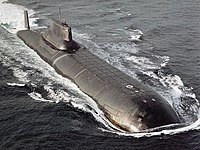
|
Ballistic missile submarine (SSBN) | HMS Velsava HMS Smrdáky |
1st fleet | 1981 | Active | 36,000 tonnes |
| HMS Smrdáky' | 3rd fleet | 1983 | Active | |||||
| HMS Admirál Ludvík Sedláček | 2nd fleet | 1986 | Active | |||||
| HMS Admirál Bohdan Krejčí | 2nd fleet | 1987 | Active | |||||
| HMS Ižkovce | 2nd fleet | 1991 | Active | |||||
| HMS Admirál Andrei Vilusek | 2nd fleet | 1994 | Active | |||||
| Brusné class | 
|
Ballistic missile submarine (SSBN) | HMS Brusné HMS Grnč HMS Kerešovce HMS Fintice HMS Bystrica |
3rd fleet | Active | 18,000 tonnes | ||
| Nuclear-powered cruise missile submarines (12) | ||||||||
| Večelkov class | 
|
Cruise missile submarine (SSGN) | HMS Večelkov HMS Melecheď HMS Řehák |
2nd fleet 1st fleet 3rd fleet |
Vyklice, Holynia Tajná, Holynia Tajná, Holynia |
13,800 tonnes | ||
| Budimír class | 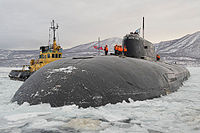
|
Cruise missile submarine (SSGN) | HMS Budimír HMS Kalameny HMS Poláček HMS Kľačany HMS Vaľkovo HMS Ložín HMS Mranov HMS Jablonec HMS Kalameny |
2nd fleet 3rd fleet 1st fleet 2nd fleet 2nd fleet 3rd fleet 1st fleet 1st fleet 1st fleet |
Vyklice, Holynia Slatnik, Holynia Tajná, Holynia Vyklice, Holynia Vyklice, Holynia Tajná, Holynia Vyklice, Holynia Vyklice, Holynia Vyklice, Holynia |
16,500 tonnes | ||
Surface fleet
Aircraft carriers
| Project | Class | Picture | Type | Boats | Fleet | Commissioned | Status | Displacement |
|---|---|---|---|---|---|---|---|---|
| Aircraft carrier (3) | ||||||||
| Project 1381 aircraft cruiser | Rakúsy class | 
|
Aircraft carrier | HMS Admiral Hugo Souček | 3rd fleet | 1978 (as Rakúsy) 2012 (as Admiral Hugo Souček) |
Active | 45,400 tonnes |
| Project 3491 aircraft carrier | Benedikt class | 
|
Aircraft carrier | HMS King Benedikt IV | 2nd fleet | 1993 | Active | 67,500 tonnes |
| Mikuláš class | 
|
Aircraft carrier | HMS King Mikuláš I | 1st fleet | 1991 | Laid up | 58,000 tonnes | |
Helicopter carrier/light aircraft carrier
| Project | Class | Picture | Type | Boats | Fleet | Commissioned | Status | Displacement |
|---|---|---|---|---|---|---|---|---|
| Helicopter carrier (1) | ||||||||
| Project 1700 landing cruiser | Prince of Brezovička class | 
|
Landing helicopter dock | HMS Prince of Brezovička | 1st fleet | 2019 | Active | 14,300 tonnes |
| HMS King Daniel II | 3rd fleet | 2023 est. | Fitting out | |||||
| HMS Admiral Bohdan Kubát | 3rd fleet | 2027 est. | Under construction | |||||
Battlecruisers
| Project | Class | Picture | Type | Boats | Fleet | Commissioned | Status | Displacement |
|---|---|---|---|---|---|---|---|---|
| Battlecruisers (3) | ||||||||
| Project 2047 heavy cruiser | Pozorká class | 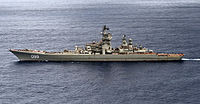
|
Battlecruiser | HMS King Pavel IV | 2nd fleet | 1988 | Active | 28,000 tonnes |
| HMS Svetlá Podzámok | 3rd fleet | 1994 | Active | |||||
| HMS Admiral Slavomír Stejskal | 1st fleet | 1998 | Active | |||||
Cruisers
| Project | Class | Picture | Type | Boats | Fleet | Commissioned | Status | Displacement |
|---|---|---|---|---|---|---|---|---|
| Guided missile cruiser (7) | ||||||||
| Project 1250 cruiser | Bartoloměj class | 
|
Guided missile cruiser | HMS Bartoloměj III | 3rd fleet | 2021 | Active | 12,000 tonnes |
| HMS Admiral Jindřich Mrázek | 1st fleet | 2023 est. | Fitting out | |||||
| HMS Prince Eduard II | 2nd fleet | 2025 est. | Keel laid | |||||
| HMS Admiral Artur Mach | 2026 est. | Planned | ||||||
| Project 1035 cruiser | Mladkov class | 
|
Guided missile cruiser | HMS Mladkov | 2nd fleet | 1984 | Active | 12,500 tonnes |
| HMS Libenov | 3rd fleet | 1987 | Active | |||||
| HMS Vanov | 1st fleet | 1989 | Active | |||||
| HMS Žleb | 3rd fleet | 1992 | Under refit | |||||
| HMS Hostinka | 3rd fleet | 1994 | Laid up | |||||
| HMS Čmeliny | 2nd fleet | 1996 | Active | |||||
Destroyers
| Project | Class | Picture | Type | Boats | Fleet | Commissioned | Status | Displacement |
|---|---|---|---|---|---|---|---|---|
| Guided missile destroyer (33 active) | ||||||||
| Project 250 destroyer | Ledetz class | 
|
Guided missile destroyer | HMS Ledetz | 3rd fleet | 2021 | Active | 7,500 tonnes |
| HMS Vyskeř | 1st fleet | 2022 est. | Fitting out | |||||
| HMS Kosmo | 3rd fleet | 2022 est. | Sea trials | |||||
| HMS Studená | 3rd fleet | 2022 est. | Under construction | |||||
| HMS Kováň | 2023 est. | Under construction | ||||||
| 6th Ledetz class ship | 2023 est. | Keel laid | ||||||
| 7th Ledetz class ship | 2023 est. | Planned | ||||||
| 8th Ledetz class ship | 2024 est. | Planned | ||||||
| Podkost class |  |
Guided missile destroyer | HMS Podkost | 3rd fleet | 2007 | Active | 7,000 tonnes | |
| HMS Zdenice | 2nd fleet | 2008 | Active | |||||
| HMS Bytina | 2nd fleet | 2010 | Active | |||||
| HMS Úžín | 3rd fleet | 2012 | Active | |||||
| HMS Malenitz | 2nd fleet | 2014 | Active | |||||
| HMS Vice Admiral Jeroným Pavlíček | 2nd fleet | 2016 | Active | |||||
| HMS Štramberk | 1st fleet | 2017 | Active | |||||
| Project 190 destroyer | Lapša class | 
|
Guided missile destroyer | HMS Lapša | 1st fleet | 1994 | Active | 7,100 tonnes |
| HMS Jazernica | 1st fleet | 1996 | Active | |||||
| HMS Sazdice | 1st fleet | 2000 | Active | |||||
| Project 170 destroyer | Lužanky class | 
|
Guided missile destroyer | HMS Lužanky | 1st fleet | 1992 | Active | 6,600 tonnes |
| HMS Soblahov | 2nd fleet | 1993 | Active | |||||
| HMS Korytnica | 2nd fleet | 1993 | Active | |||||
| HMS Šindelová | 2nd fleet | 1994 | Active | |||||
| Eule class | 
|
Guided missile destroyer | HMS Cizekporok | 1st fleet | 1986 | Active | 6,600 tonnes | |
| HMS Šebkovice | 2nd fleet | 1988 | Active | |||||
| HMS Brloh | 1st fleet | 1989 | Laid up | |||||
| HMS Nupaky | 3rd fleet | 1990 | Active | |||||
| HMS Citov | 3rd fleet | 1990 | Laid up | |||||
| HMS Urmín | 3rd fleet | 1991 | Under refit | |||||
| Project 166 destroyer | Slavníč II class | 
|
Guided missile destroyer/Anti-submarine destroyer | HMS Klaub | 3rd fleet | 1990 | Active | 6,920 tonnes |
| HMS Vlasatice | 3rd fleet | 1990 | Active | |||||
| HMS Podhoří | 1st fleet | 1991 | Active | |||||
| HMS Bradlné | 3rd fleet | 1991 | Under refit | |||||
| HMS Krupá | 1st fleet | 1992 | Active | |||||
| HMS Pirken | 2nd fleet | 1993 | Active | |||||
| Slavníč class | 
|
Guided missile destroyer/Anti-submarine destroyer | HMS Vojany | 3rd fleet | 1981 | Active | 6,900 tonnes | |
| HMS Beretke | 1st fleet | 1982 | Active | |||||
| HMS Palota | 2nd fleet | 1985 | Under refit | |||||
| HMS Kokošová | 2nd fleet | 1986 | Active | |||||
| HMS Starkstadt | 3rd fleet | 1988 | Active | |||||
| HMS Cetyně | 3rd fleet | 1989 | Active | |||||
Frigates
| Project | Class | Picture | Type | Boats | Fleet | Commissioned | Status | Displacement |
|---|---|---|---|---|---|---|---|---|
| Frigates (24 active) | ||||||||
| Project 590 frigate | Vahaneč class | 
|
Guided missile frigate | HMS Vahaneč | 2nd fleet | 2009 | Active | 5,400 tonnes |
| HMS Vyklice | 1st fleet | 2009 | Active | |||||
| HMS Jilem | 3rd fleet | 2010 | Active | |||||
| HMS Liberk | 2nd fleet | 2011 | Active | |||||
| HMS Statenice | 3rd fleet | 2012 | Active | |||||
| HMS Terchová | 1st fleet | 2014 | Active | |||||
| HMS Brunvirt | 3rd fleet | 2016 | Active | |||||
| HMS Rodik | 3rd fleet | 2017 | Active | |||||
| HMS Spodnja | 3rd fleet | 2019 | Active | |||||
| HMS Scopo | 1st fleet | 2020 | Active | |||||
| HMS Stankovo | 2nd fleet | 2022 est. | Fitting out | |||||
| HMS Tajanov | 2022 est. | Under construction | ||||||
| HMS Úterý | 2023 est. | Under construction | ||||||
| HMS Venkov | 2023 est. | Keel laid | ||||||
| HMS Bytca | 2024 est. | Keel laid | ||||||
| 11th Vahaneč class ship | 2024 est. | Planned | ||||||
| 12th Vahaneč class ship | 2025 est. | Planned | ||||||
| Project 530 frigate | Admiral Libor Čapek class | 
|
Guided missile frigate | HMS Admiral Libor Čapek | 1st fleet | 2000 | Active | 4,035 tonnes |
| HMS Milná | 2nd fleet | 2001 | Active | |||||
| HMS Podmilesy | 1st fleet | 2002 | Active | |||||
| HMS Mosnig | 3rd fleet | 2003 | Active | |||||
| HMS Twrdina | 3rd fleet | 2004 | Active | |||||
| HMS Svatobor | 2nd fleet | 2005 | Active | |||||
| HMS Venkov | 2nd fleet | 2005 | Active | |||||
| HMS Hostomitz | 3rd fleet | 2006 | Active | |||||
| HMS Venkov | 2nd fleet | 2007 | Active | |||||
| HMS Zbirow | 1st fleet | 2007 | Active | |||||
| Šťastný class | 
|
Guided missile frigate | HMS Šťastný | 1st fleet | 1995 | Active | 3,620 tonnes | |
| HMS Stranná | 1st fleet | 1997 | Active | |||||
| HMS Suniperk' | 1st fleet | 1997 | Active | |||||
| Cricova class | 
|
Guided missile frigate | HMS Admiral Ivan Sedlák' | 3rd fleet | 1992 | Active | 3,575 tonnes | |
Corvettes
| Project | Class | Picture | Type | Boats | Fleet | Commissioned | Status | Displacement |
|---|---|---|---|---|---|---|---|---|
| Corvettes (26) | ||||||||
| Project 714 corvette | Ploscise class | 
|
Guided missile corvette | HMS Ploscise | 2nd fleet | 2005 | Active | 2,100 tonnes |
| HMS Gajevci | 3rd fleet | 2006 | Active | |||||
| HMS Brunvirt | 3rd fleet | 2008 | Active | |||||
| HMS Gmajnica | 2nd fleet | 2008 | Active | |||||
| HMS Medija | 1st fleet | 2009 | Active | |||||
| HMS Pobegi | 1st fleet | 2009 | Active | |||||
| HMS Nedelica | 3rd fleet | 2010 | Active | |||||
| HMS Pucaie | 2nd fleet | 2011 | Active | |||||
| HMS Konjsko | 1st fleet | 2017 | Active | |||||
| HMS Hotemaže | 2nd fleet | 2017 | Active | |||||
| HMS Gerlinci | 3rd fleet | 2018 | Active | |||||
| Project 610 corvette | Nitra class | 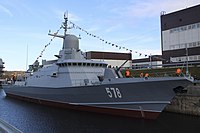
|
Guided missile corvette | HMS Nitra | 2nd fleet | 2014 | Active | 800 tonnes |
| HMS Gradnik | 1st fleet | 2015 | Active | |||||
| HMS Štajngrova | 1st fleet | 2016 | Active | |||||
| HMS Mostečno | 3rd fleet | 2016 | Active | |||||
| HMS Virštanj | 3rd fleet | 2017 | Active | |||||
| HMS Grintavica | 2nd fleet | 2018 | Active | |||||
| Project 1871 missile ship | Admiral Ivan Bris class | 
|
Guided missile corvette | HMS Ročinj | 2nd fleet | 1980 | Active | 560 tonnes |
| HMS Todraž | 1st fleet | 1983 | Active | |||||
| HMS Gorenjcj | 2nd fleet | 1984 | Active | |||||
| HMS Liberk | 3rd fleet | 1986 | Active | |||||
Amphibious assault ships
| Class | Picture | Type | Boats | Fleet | Commissioned | Status | Displacement |
|---|---|---|---|---|---|---|---|
| Sliačany class | 
|
Amphibious transport dock | HMS Sliačany | 1st fleet | 2017 | Active | 25,500 tonnes |
| HMS Vydrník | 3rd fleet | 2018 | Active | ||||
| HMS Rychnava | 2nd fleet | 2019 | Active | ||||
| Kykula class | 
|
Landing ship | HMS Kykula | 3rd fleet | 2016 | Active | 6,600 tonnes |
| HMS Bakta | 2nd fleet | 2018 | Active | ||||
| Smrečany class | 
|
Landing ship | HMS Piargy | 1st fleet | 1975 | Active | 3,400 tonnes |
| HMS Nesluša | 3rd fleet | 1978 | Active | ||||
| HMS Kamenec | 2nd fleet | 1979 | Active | ||||
| HMS Kajal | 1st fleet | 1981 | Active | ||||
| Smrečany class | 
|
Landing ship | HMS Zábidovo | 1st fleet | 1967 | Active | 2,200 tonnes |
| HMS Žalobín | 3rd fleet | 1968 | Active | ||||
| HMS Ochodnica | 3rd fleet | 1969 | Active | ||||
| HMS Horní Hričov | 2nd fleet | 1972 | Active | ||||
| HMS Bánová | 1st fleet | 1973 | Active | ||||
| HMS Zalabska Pusta | 2nd fleet | 1978 | Active |







